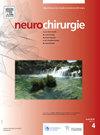腰椎后路融合术早期机械失效:基于一例说明性病例的文献回顾。
IF 1.4
4区 医学
Q4 CLINICAL NEUROLOGY
引用次数: 0
摘要
背景:后路腰椎融合术(PLF)已成为最常见的脊柱手术之一。早期症状性椎弓根螺钉松动可能是一个严重的并发症,导致假关节。然而,椎弓根螺钉松动的翻修策略仍在争论中。目的与方法:结合1例临床病例,对椎弓根螺钉松动的危险因素、病因、手术修复方案及预后进行文献回顾。结果:我们描述了一例由于脓毒性原因导致后路L4-L5关节融合术早期机械失效的临床病例。翻修手术包括采用ALIF、后路大螺钉和关节融合术进行环周手术。文献综述强调了螺钉松动的许多危险因素,并强调了在有风险的患者进行指数手术时安装椎间装置的重要性。在螺丝松动的情况下,应进行系统的细菌学取样。有症状的螺钉松动应从翻修手术中获益。翻修手术有多种选择,包括前路翻修和后路螺钉翻修。结论:本综述强调了PLF初始手术的关键因素,感染性病因在椎弓根螺钉松动中的重要性,以及面对早期机械故障时的手术策略。本文章由计算机程序翻译,如有差异,请以英文原文为准。
Early mechanical failure of posterior lumbar fusion: Literature review based on an illustrative case
Background
Posterior lumbar fusion (PLF) has become one of the most common spinal surgery procedures. Early symptomatic loosening of the pedicle screw could be a critical complication, leading to pseudarthrosis. However, revision strategies for pedicle screw loosening are still under debate.
Objective & methods
Based on a clinical case, we conducted a literature review of pedicle screw loosening, its risk factors, aetiologies, surgical revision options and outcomes.
Results
We describe a clinical case of early mechanical failure of a posterior L4-L5 arthrodesis due to septic cause. Revision surgery consisted of circumferential surgery using ALIF, posterior larger screws and extension of the arthrodesis.
The review of the literature highlights numerous risk factors for screw loosening and underlines the importance of fitting an interbody device during index surgery in patients at risk.
In the event of a screw loosening, bacteriological samples should be systematic.
Symptomatic screw loosening should benefit from revision surgery. There are various options for revision surgery, including anterior revision and the revision of posterior screws.
Conclusion
This review highlights the key elements of initial PLF surgery, the importance of septic aetiology in pedicle screw loosening, and suggested surgical strategies in the face of early mechanical failure.
求助全文
通过发布文献求助,成功后即可免费获取论文全文。
去求助
来源期刊

Neurochirurgie
医学-临床神经学
CiteScore
2.70
自引率
6.20%
发文量
100
审稿时长
29 days
期刊介绍:
Neurochirurgie publishes articles on treatment, teaching and research, neurosurgery training and the professional aspects of our discipline, and also the history and progress of neurosurgery. It focuses on pathologies of the head, spine and central and peripheral nervous systems and their vascularization. All aspects of the specialty are dealt with: trauma, tumor, degenerative disease, infection, vascular pathology, and radiosurgery, and pediatrics. Transversal studies are also welcome: neuroanatomy, neurophysiology, neurology, neuropediatrics, psychiatry, neuropsychology, physical medicine and neurologic rehabilitation, neuro-anesthesia, neurologic intensive care, neuroradiology, functional exploration, neuropathology, neuro-ophthalmology, otoneurology, maxillofacial surgery, neuro-endocrinology and spine surgery. Technical and methodological aspects are also taken onboard: diagnostic and therapeutic techniques, methods for assessing results, epidemiology, surgical, interventional and radiological techniques, simulations and pathophysiological hypotheses, and educational tools. The editorial board may refuse submissions that fail to meet the journal''s aims and scope; such studies will not be peer-reviewed, and the editor in chief will promptly inform the corresponding author, so as not to delay submission to a more suitable journal.
With a view to attracting an international audience of both readers and writers, Neurochirurgie especially welcomes articles in English, and gives priority to original studies. Other kinds of article - reviews, case reports, technical notes and meta-analyses - are equally published.
Every year, a special edition is dedicated to the topic selected by the French Society of Neurosurgery for its annual report.
 求助内容:
求助内容: 应助结果提醒方式:
应助结果提醒方式:


